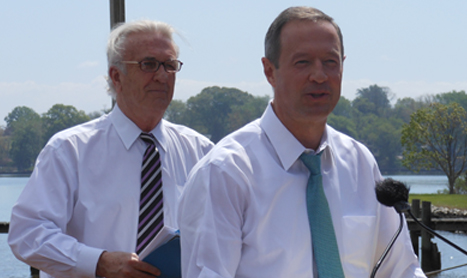ANNAPOLIS – The Chesapeake Bay’s blue crab population is at a 19-year high, a significant improvement from several years ago when conservation efforts were put in place.
Gov. Martin O’Malley made the announcement at Mike’s Crab House in Riva Thursday, where he discussed the Maryland Department of Natural Resources’ annual winter dredge survey.
“In 2008, I told you that the crab population was at a 19-year low and that the crab population was in great danger,” O’Malley said. “Because of a different set of better choices that all of us have made together, I am now glad to report that the population of the blue crab is now at a 19-year high.”
The announcement is a continuation of last year’s success, when the blue crab population saw the second highest survival rate since 1997, despite an extremely cold winter.
O’Malley said the success of the blue crabs is positive for watermen, the bay, jobs and economic recovery.
There has been a lot of legislation this year related to the bay, he said, including bills on septic systems, stormwater runoff, and a hike in the flush fee.
“One of the clearest indications that the health of the bay is not a hopeless cause is the rebound of late of this blue crab population,” O’Malley said.
A few years ago, female crabs were being overfished and the fishery was at risk of collapse, O’Malley said.
In 2008, Maryland coordinated efforts with Virginia and the Potomac River Fisheries Commission to reduce stress on the blue crab population through conservation, and by reducing harvests on the female crabs by 34 percent.
Department of Natural Resources Fisheries Director Tom O’Connell said the difficult decisions the two governors made has fostered a relationship between Maryland and Virginia, and positive progress forward is evident.
Not only is the crab population at a 19-year high, with about 66 percent more crabs living in the bay than last year, but the juvenile crab population reached a record level.
The number of juvenile blue crabs totals 587 million, almost triple the number for last year.
Despite the general success of Maryland’s blue crab population, the number of spawning-age female crabs has dropped, though it still remains above a safe threshold.
Thomas Miller, a professor of fisheries science at the University of Maryland, said there are three possible explanations for the decrease in the female population.
The warm weather may have affected the location of the crabs, he said, and they may not have been in areas they typically inhabit, and they also could have moved to slightly offshore waters.
The other factor to consider is variability.
“This is a survey, it’s not a census,” he said.
Miller said the survey is designed to minimize variability, but there will always be some difference in estimates because there is no way to tell where all the crabs are.
“We still have a lot of work ahead of us, but it is an important milestone,” O’Malley said.
Progress wouldn’t have happened if we had continued with the same behavior and hoped for a different result, he said.
“The crab’s iconic,” O’Malley said. “The crab represents, for so many people, some of the best moments they share with family in this region of our country.”

